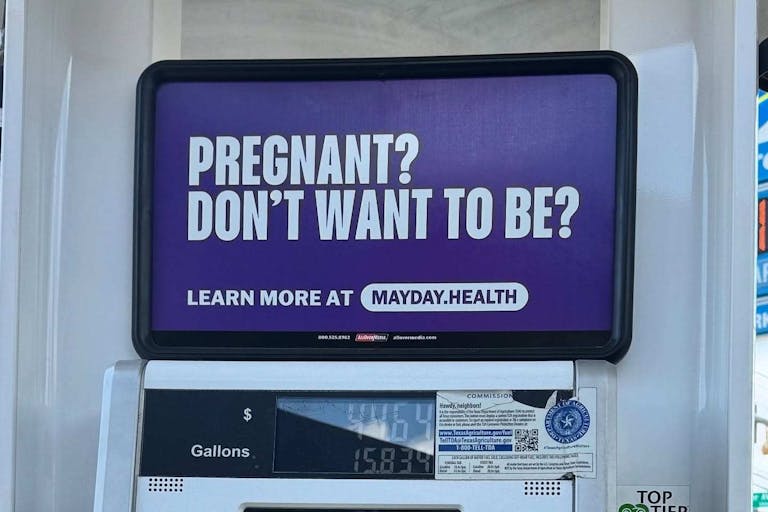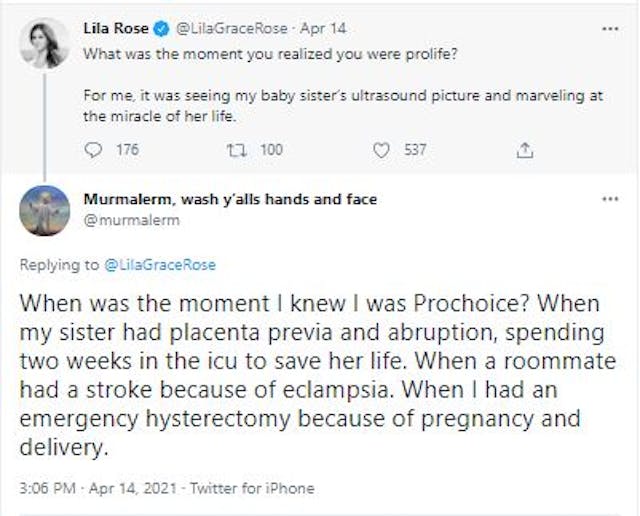
South Dakota sues Mayday Health over gas station abortion ads
Bridget Sielicki
·
Pregnant women with medical emergencies deserve real health care – and that isn’t abortion
Recently, Live Action president and founder Lila Rose took to Twitter to ask her followers about the moment they realized they were pro-life. For her, it was seeing her younger sister’s ultrasound image and “marveling at the miracle of her life.” Pro-abortion Twitter users began to tweet back, with one sharing that medical emergencies that happened to friends and family were what led her to support abortion.
“When was the moment I knew I was Prochoice?” wrote @murmalerm. “When my sister had placenta previa and abruption, spending two weeks in the icu to save her life. When a roommate had a stroke because of eclampsia. When I had an emergency hysterectomy because of pregnancy and delivery.”
While the details of the events that unfolded surrounding these heartbreaking and frightening medical emergencies are unknown, assumptions should not be made to downplay just how serious these situations were. Eclampsia is a life-threatening and severe complication that can occur when a woman has preeclampsia — a condition involving high blood pressure that can worsen and become eclampsia, causing seizures and coma — and in this case, a stroke. Eclampsia can be deadly for both mom and baby and usually occurs late in pregnancy.

READ: Why miscarriage, ectopic pregnancy, and early delivery are not abortions
Placenta previa is when the placenta partially or totally covers the mother’s cervix. It can cause severe bleeding usually at or after the 20th week of pregnancy and the placenta may separate from the uterine wall as the cervix dilates during labor. It can lead to preterm labor and hemorrhaging. It is life-threatening.
It’s important to note that life-threatening pregnancy complications don’t typically occur until the 20th week of pregnancy or after. “While we do see early severe preeclampisa/HELLP on occasion, I have never seen it at such an early gestational age that the fetus does not at least have a chance at survival,” explained Dr. Ingrid Skop, an American College of Obstetrics and Gynecology Fellow.
While we don’t know the full details of these health crises or any of the details as to why @murmalerm herself had to undergo an emergency hysterectomy, what is known is that intentionally killing a preborn child would not have saved the lives of any of these women. Do these women’s lives and health matter? Absolutely. Women deserve the best and most appropriate health care when facing medical emergencies while pregnant. That care does not include abortion, the deliberate killing of the woman’s child.
An abortion procedure always carries the intention of killing a preborn child, but a child need not be killed to end a pregnancy.
Preterm Delivery
When a pregnant woman faces a medical emergency, she needs and deserves the fastest and safest health care available. In a tragic situation in which a child is delivered too prematurely to survive, this is not an abortion. Preterm delivery with the goal of helping the baby to survive is the best option for a woman’s physical and emotional health, and doctors must act quickly if a woman’s life (and by extension, her baby’s life) is at risk. Inducing preterm labor to save a woman’s life is not abortion and the baby is delivered faster.
In contrast, an abortion would also involve the preterm labor and delivery, with the added work of killing and dismembering the baby first. This is not only completely unnecessary, but can add hours, and even days, to a timeline in which every second counts. A later abortion at this stage can take two to three days.
Article continues below
Dear Reader,
In 2026, Live Action is heading straight where the battle is fiercest: college campuses.
We have a bold initiative to establish 100 Live Action campus chapters within the next year, and your partnership will make it a success!
Your support today will help train and equip young leaders, bring Live Action’s educational content into academic environments, host on-campus events and debates, and empower students to challenge the pro-abortion status quo with truth and compassion.
Invest in pro-life grassroots outreach and cultural formation with your DOUBLED year-end gift!
“The uterus does need to be evacuated [in these dire situations], and we do this by inducing labor, not by D&E [abortion],” said Dr. Skop.
Emergency C-section
When preterm labor is not an option, an emergency C-section is much faster and safer than abortion for a woman, especially for a condition such as placenta previa. An abortion in which an abortionist accesses the womb through the cervix would actually be extremely dangerous since the abortionist would have to insert tools into the cervix, which is blocked by the placenta. This could lead to a life-threatening hemorrhage.
“The safest thing for the mom in that situation would absolutely be a C-section,” said Dr. Christina Francis, Chair of the Board of the American Association of Prolife OB/GYNs. “That is the fastest and safest way to control the bleeding.”
Dr. Skop agreed, stating, “I still can’t understand why they are willing to recommend abortion for placenta previa. Intentionally placing a surgical instrument through a placenta gives me chills! … [A] skilled physician can save both lives with standard obstetric techniques.”
An emergency C-section takes just minutes to carry out while an abortion would take at least two days. With a C-section, her premature baby has a chance of survival. With abortion, a baby always dies.
Emergency Surgery
One life-threatening situation that occurs early in pregnancy is ectopic pregnancy. This situation in which a child has implanted in the Fallopian tube can be deadly for the mother and the baby. Surgery to remove that tube and baby, however, is not an abortion. The baby is not actively and intentionally killed prior to the surgery but tragically dies as a result of the surgery, without which the mother and baby would have both died.
When facing a life-threatening health crisis during pregnancy, abortion is not the safest, fastest, or best option, and it is the deliberate killing of a human being — and therefore it shouldn’t be an option at all. Doctors should instead try to save both mother and child instead of pushing for abortion when it is not the best option for anyone involved.
Giving every baby a chance is the right thing to do — both ethically and medically — and provides the mother with real health care.
“Like” Live Action News on Facebook for more pro-life news and commentary!
Live Action News is pro-life news and commentary from a pro-life perspective.
Contact editor@liveaction.org for questions, corrections, or if you are seeking permission to reprint any Live Action News content.
Guest Articles: To submit a guest article to Live Action News, email editor@liveaction.org with an attached Word document of 800-1000 words. Please also attach any photos relevant to your submission if applicable. If your submission is accepted for publication, you will be notified within three weeks. Guest articles are not compensated (see our Open License Agreement). Thank you for your interest in Live Action News!

Bridget Sielicki
·
Analysis
Cassy Cooke
·
Analysis
Cassy Cooke
·
Analysis
Cassy Cooke
·
Analysis
Cassy Cooke
·
Analysis
Nancy Flanders
·
Politics
Nancy Flanders
·
Human Interest
Nancy Flanders
·
Issues
Nancy Flanders
·
Human Interest
Nancy Flanders
·
Politics
Nancy Flanders
·